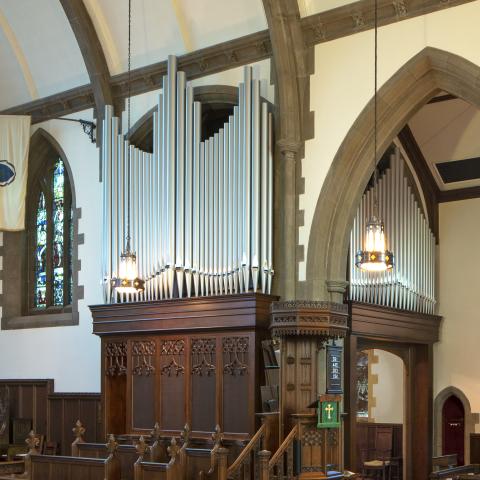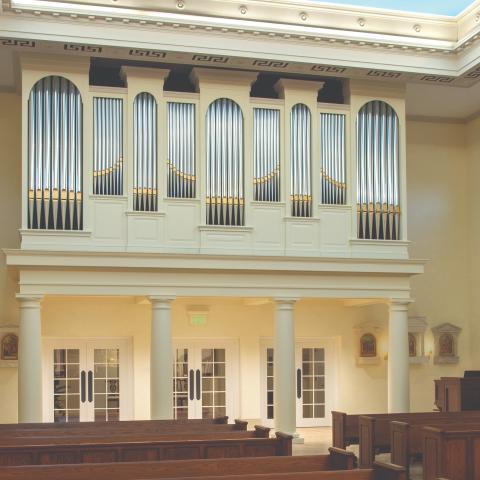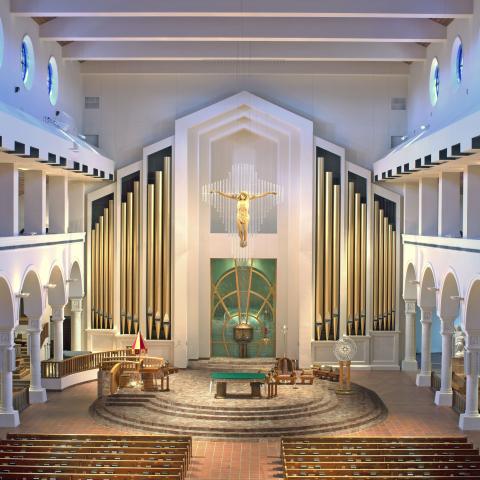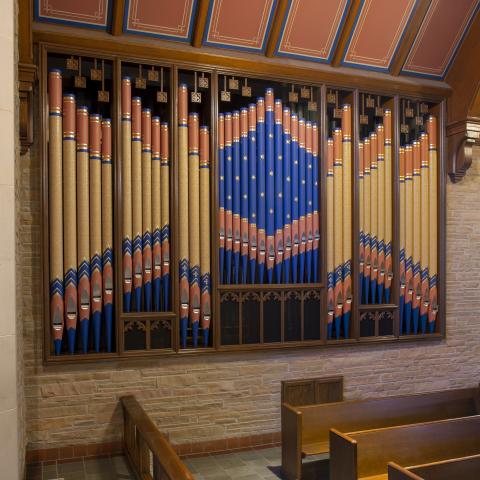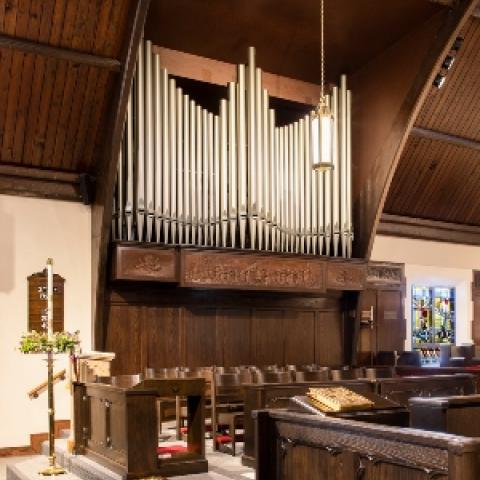
Schoenstein & Co., Benicia, California
Mikell Chapel, Cathedral of Saint Philip, Atlanta, Georgia
A small instrument in a busy Episcopal cathedral chapel carries a heavy load of musical responsibility. In one day it may have to serve a small family funeral, a wedding filled to capacity, a rehearsal, and a service. In Mikell Chapel there is daily Morning Prayer and on Sunday two morning Eucharists and a Spanish language Eucharist. It is the main practice organ and often used in small musical programs and student recitals.
A variety of tonal color is important, but even more so is expression control, especially in a small instrument. We like to have everything under expression with the possible exception of a 16′ independent Pedal stop. In some cases, however, there is no way to place Great and Swell side-by-side so the Great must be unexpressive. For this instrument and several others we have adapted E. M. Skinner’s characteristically practical as well as artistic solution: a luxuriously complete Swell organ with just one or two stops in the Great and Pedal plus borrows from the Swell. One way to get variety from a limited number of stops is to avoid repetition of tone colors. Also, 70% of the voices are at 8′ pitch and below—where tonal color counts most. Finally, the Swell includes our double expression system for the higher pressure Trumpet and Gambas, giving the Swell an extended dynamic range.
Mikell Chapel was served by an electronic organ for many years but had a chamber prepared for a future pipe organ. It is perhaps one of the most strangely shaped chambers we have ever encountered, and the tone opening into the chapel is quite limited. The bulk of the chamber was used for the Swell with the two Great stops directly behind the tone opening. To accommodate the very unusual chamber layout, the pipes of the 16′ Swell Bourdon are placed horizontally on the chamber floor. The independent Pedal Sub Bass was placed in display in the southwest corner of the chapel near the console.
Special attention was given to make the console playing aids and accessories comparable to the Schoenstein console that controls the Aeolian-Skinner in the Cathedral Church. This makes the chapel organ an effective vehicle for practice when the church is not available.
The instrument, known as the Thomas Ruben Jones Memorial Organ, was given in memory of Thomas Ruben Jones (1929–2014) by Delbert Lowell Jacks. The organ was completed in 2018 and presented in recitals by David Fishburn and Patrick A. Scott on March 2, and by Marie Pettet on March 3. The organ was dedicated in a Eucharist celebrated by the Very Reverend Samuel G. Candler, dean of the cathedral on March 4. The organ project was under the direction of David Rocchio, director of stewardship and gift planning, and David Fishburn, representing the music department headed by Dale Adelmann, canon for music.
—Jack M. Bethards, President and Tonal Director, Schoenstein & Co. Pipe Organ Builders
Builder’s website: https://schoenstein.com.
Cathedral website: www.cathedralatl.org.
Photo credit: Louis Patterson
GREAT (Manual I)
16′ Bourdon (Swell)
8′ Open Diapason 61 pipes
8′ Horn Diapason (Swell)
8′ Gamba (Swell)
8′ Gamba Celeste (Swell)
8′ Silver Flute (Swell)
8′ Chimney Flute (Swell)
4′ Principal 61 pipes
4′ Chimney Flute (Swell)
2′ Fifteenth (Swell)
2′ Mixture (III – Swell)
8′ Trumpet (Swell)
8′ Clarinet (Swell)
Great 16
Great Unison Off
Great 4 ††
SWELL (Manual II, expressive)
16′ Bourdon (ext 8′ Ch. Fl.) 12 pipes
8′ Horn Diapason 61 pipes
8′ Gamba† 61 pipes
8′ Gamba Celeste (TC)† 49 pipes
8′ Silver Flute (Ch. Fl. bass) 49 pipes
8′ Chimney Flute 61 pipes
4′ Gemshorn 61 pipes
4′ Chimney Flute (ext 8′) 12 pipes
22⁄3′ Nazard (Chimney Flute)
2′ Fifteenth (ext Gemshorn) 12 pipes
13⁄5′ Tierce (TC) 42 pipes
2′ Mixture (III)†† 166 pipes
16′ Contra Oboe 73 pipes
8′ Trumpet † 61 pipes
8′ Oboe Horn (ext)
8′ Clarinet 61 pipes
Tremulant
Swell 16
Swell Unison Off
Swell 4 ††
PEDAL
32′ Resultant
16′ Sub Bass (Bourdon treble) 27 pipes
16′ Bourdon (Swell)
8′ Principal (Gt, 8′ Open Diapason)
8′ Horn Diapason (Swell)
8′ Gamba (Swell)
8′ Chimney Flute (Swell)
4′ Fifteenth (Gt, 8′ Open Diapason)
4′ Silver Flute (Swell)
16′ Contra Oboe (Swell)
8′ Trumpet (Swell)
8′ Oboe (Swell)
8′ Clarinet (Swell)
4′ Oboe (Swell)
4′ Clarinet (Swell)
Couplers
Great to Pedal
Great to Pedal 4
Swell to Pedal
Swell to Pedal 4
Swell to Great 16
Swell to Great
Swell to Great 4
† Stops under double expression
†† Mixture cut out with coupler
2 manuals, 16 ranks, 930 pipes

